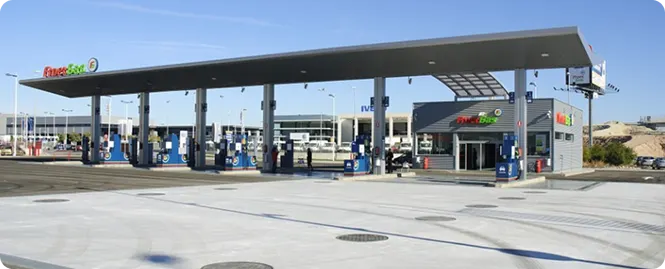How to Open a Gas Station in Kentucky
Table of Contents
Key Takeaways
-
Research the gas station business in Kentucky, including profitability, market demand, and competition.
-
Choosing a high-traffic area with strong demand and minimal competition is crucial for success.
-
A solid business plan, startup cost analysis, and securing funding through loans, investors, or grants will help set up the business.
-
Obtaining the necessary permits and licenses and adhering to environmental and zoning laws are essential steps.
-
Efficient inventory management, competitive pricing, and promotions through social media and loyalty programs will help maximize revenue.
Kentucky’s gas station industry is more than just fuel pumps and convenience stores—it’s a thriving business opportunity. With steady demand, strong profit margins on fuel and retail sales, and potential for expansion, opening up a gas station here can be a lucrative venture. However, success isn’t just about selling gas; it's about smart location choices, competitive pricing, and diversifying revenue streams. Whether it’s fuel, snacks, or car services, every sale adds up to long-term profitability.
Opening a gas station in Kentucky requires careful planning and attention to detail. From securing permits and licenses to choosing the right business structure, every step plays an important role in long-term success. Understanding financial requirements, market demand, and supplier contracts helps create a solid foundation. A well-prepared business plan ensures smoother operations, making navigating challenges easier and maximizing profitability. Launching a gas station can be a rewarding and profitable venture with the right approach.
Step 1: Researching the Market and Location
Choosing the perfect location for a gas station in Kentucky requires more than just picking a busy road. High-traffic areas near highways, intersections, or growing communities provide steady customers, but accessibility matters just as much. Drivers favor stations that are easy to enter and exit, with clear signage and enough space to move. Proximity to local businesses, residential areas, or trucking routes can boost foot traffic, making your station a convenient stop for daily commuters.
Analyzing the local demand and competition gives you a strategic edge. Studying traffic patterns, peak fueling hours, and competitor pricing in the area can help identify gaps in the market. Zoning laws and upcoming infrastructure projects can impact long-term success, so researching these factors early on can prevent any costly mistakes. Additionally, understanding seasonal demand fluctuations—such as increased road trips in summer—can help optimize pricing and promotions, ensuring consistent profitability throughout the year.
Fuel preferences and customer habits can vary region by region. Some areas might demand more diesel, while others lean toward premium gas. Offering competitive pricing, loyalty programs, and a well-stocked convenience store can encourage repeat business. A station that meets local needs creates loyal customers and boosts long-term profitability.
Step 2: Creating a Business Plan
A well-crafted business plan is the backbone of a successful gas station. It lays out your vision, financial needs, and operational strategies, giving you a clear roadmap. This document is essential for securing funding, staying organized, and making informed decisions. Without a solid plan, managing startup costs, fuel pricing, and daily operations can become overwhelming. A structured approach helps you anticipate challenges, capitalize on opportunities, and keep your business running efficiently in a competitive industry.
Your business plan should include key elements such as financial projections, marketing strategies, and revenue goals for your venture. Break down the costs, expected profit margins, and funding sources. Outline promotional tactics to attract customers and establish competitive pricing models. A well-detailed plan not only reassures investors but also keeps you on track. It should serve as a living document, evolving with market trends and business growth, ensuring you stay ahead in an ever-changing industry.
Long-term success goes beyond just launching your gas station—it requires a forward-thinking strategy. Consider future expansion, such as adding a convenience store, car wash, or EV charging stations to increase revenue streams. Stay adaptable to shifts in fuel demand, emerging technologies, and evolving customer preferences. Establishing clear, measurable goals keeps your business on a steady growth path. A strong long-term plan ensures sustainability, helping you navigate challenges and keep your gas station thriving for years.
Step 3: Legal and Regulatory Requirements
Starting a gas station in Kentucky involves more than just securing a prime location—you will need the right permits and licenses. Business registration, tax identification, and fuel storage permits are just the beginning. Health and safety approvals, environmental clearances, and fire department certifications are crucial. Ensuring compliance with state and federal fuel regulations protects your business from costly fines. Proper documentation streamlines your launch, making the process smoother and preventing legal headaches down the road.
Understanding Kentucky’s zoning laws is essential before breaking ground. Local regulations dictate where gas stations can operate, affecting everything from property setbacks to environmental impact assessments. Some areas may require special use permits or restrict fuel stations from being built near schools and residential zones. Compliance with fire codes, underground storage tank rules, and accessibility laws is non-negotiable. Researching and working with local authorities ensures your approval process is smooth and avoids any costly delays.
Operating a gas station means handling hazardous materials, making environmental compliance a top priority. Kentucky enforces strict regulations on fuel storage, spill prevention, and waste disposal. Underground and aboveground storage tanks must meet EPA standards, with regular inspections to prevent contaminant leaks. Stormwater management and air quality regulations also apply. Failing to meet these requirements can result in heavy penalties and environmental damage. Staying informed and compliant protects both your business and the surrounding community.
Step 4: Securing Financing
Launching a gas station in Kentucky requires significant capital, but multiple financing options are available. Traditional bank loans, Small Business Administration (SBA) loans, and private investors can provide funding based on your business plan and creditworthiness. Some entrepreneurs choose franchise financing, leveraging brand support to secure lower interest rates. Equipment leasing is another option to minimize upfront costs. Understanding these funding sources allows you to make informed financial decisions, setting your business up for success.
A solid business plan is your ticket to securing well-rounded funding. Financial documents such as cash flow projections, balance sheets, and expense breakdowns demonstrate how viable your business is. Lenders and investors want to see clear revenue models, risk assessments, and return-on-investment timelines. A compelling pitch backed by detailed market research and strong financials increases your overall credibility. Organizing your documents professionally and preparing for tough questions will improve your chances of approval.
Small business owners in Kentucky can benefit from various government programs that are specifically designed to support entrepreneurs. The Small Business Administration (SBA) offers loan guarantees that reduce financial risk for lenders, making it easier to secure capital. State-level economic development programs provide grants or low-interest loans to qualifying businesses. Additionally, environmental incentives may be available for stations using alternative fuels. Researching these programs can help reduce hefty startup costs and make financing more accessible.
Step 5: Selecting the Right Equipment and Suppliers
Running a gas station requires more than just having fuel pumps. Essential equipment can include underground storage tanks, high-quality fuel dispensers, and a reliable point-of-sale (POS) system to process transactions efficiently. Security cameras, fire suppression systems, and digital price displays ensure safety and convenience. Additionally, having an automated inventory management system helps track fuel levels and sales data. Investing in durable, high-performance equipment ensures smooth operations, minimizes maintenance issues, and enhances the customer experience.
Choosing the right fuel supplier is a critical decision that has a direct impact on your station’s profitability. Comparing multiple suppliers based on pricing, fuel quality, and delivery reliability can help secure the best deal. Long-term contracts offer better rates, but flexibility is important in fluctuating markets. Understanding contract terms, including minimum purchase requirements and branding commitments, prevents unexpected costs. Strong supplier relationships ensure a steady fuel supply, competitive pricing, and support for promotional deals.
A gas station is not only a place to refuel—it’s an opportunity to maximize profits through additional services. A well-stocked convenience store with snacks, drinks, and essential items to go can drive up sales. Adding services like a car wash, auto repair, or even a small café can attract more customers. Lottery tickets, ATMs, and air pumps are small additions that generate steady revenue. Diversifying services boost profitability and make your station a one-stop destination.
Step 6: Building and Designing the Gas Station
Building a gas station involves strategic planning to ensure efficiency and customer convenience. The layout should allow for smooth traffic flow, with ample space for fueling, parking, and entering the convenience store. Canopies provide shelter, while well-placed lighting enhances safety. Choosing durable, low-maintenance materials reduces long-term costs. Interior store design should prioritize easy navigation, with essential items near the entrance. A well-thought-out construction plan ensures a functional, visually appealing station that attracts and retains customers.
Safety is a top priority when constructing a gas station. Compliance with fire codes, proper ventilation, and high-quality fuel storage systems prevent hazardous incidents. Accessibility features, like ramps and clearly marked pathways, make the station inclusive for all customers. Security measures like surveillance cameras and well-lit areas enhance safety. Adhering to environmental regulations ensures responsible fuel handling. Meeting all safety and legal requirements from the start prevents costly fines and operational delays in the future.
A well-designed gas station encourages repeat business. Wide driveways, clear signage, and an organized store layout create a seamless experience. An inviting atmosphere with bright lighting, clean facilities, and modern aesthetics improves customer satisfaction. The thoughtful placement of checkout counters and restrooms enhances convenience. A positive first impression keeps customers returning.
Step 7: Hiring and Training Employees
Building a reliable team is essential for running a successful gas station. Hiring friendly, efficient customer service representatives helps ensure a positive experience for visitors. Managers should have strong leadership and problem-solving skills to oversee daily operations. Maintenance staff must be skilled in handling minor repairs and ensuring safety protocols are followed. Conducting thorough interviews, checking references, and offering competitive wages help attract the best candidates. A well-rounded team keeps operations smooth and customers satisfied.
Proper training sets employees up for success and minimizes risks. Staff should be well-versed in handling fuel pumps, managing cash registers, and responding to unexpected emergencies such as spills or fires. Customer service training helps enhance interactions and builds loyalty. Clear guidelines on theft prevention, store cleanliness, and product restocking improve efficiency. Providing continuous training sessions ensures employees stay updated on industry standards. A knowledgeable and confident workforce creates a safer, more efficient gas station.
Managing staff schedules efficiently keeps operations running without disruption. A rotating schedule balances workload and prevents burnout. Using digital scheduling software helps employees track shifts and request changes easily. Payroll systems should ensure timely, accurate compensation while handling tax deductions and benefits. Streamlining these processes improves job satisfaction and efficiency.
Step 8: Marketing and Promotion
Spreading the word about your new gas station is key to attracting customers. Eye-catching signage, grand opening discounts, and limited-time fuel promotions can generate buzz. Direct mail campaigns targeting nearby residents and businesses help increase awareness. Hosting a launch event with free giveaways or discounted fuel can drive traffic and create a strong first impression. Partnering with local radio stations or newspapers can boost visibility. The goal is to be the go-to station in town.
A strong online presence is an asset in today’s digital market. Create social media pages on Facebook or Instagram to share any updates, promotions, and fuel price alerts. Engage with potential customers by responding to comments and messages. Launching a loyalty program with discounts or free rewards encourages repeat business. Limited-time promotions, such as “discounted gas on Tuesdays,” can create weekly rushes. The more engaging and rewarding the experience, the more likely customers will return.
Building relationships with nearby businesses and community organizations can significantly boost your gas station’s visibility. Offer exclusive discounts to employees of local businesses or sponsor community events. Collaborate with food trucks, car wash services, or auto repair shops for cross-promotions. Supporting local charities or youth sports teams also fosters goodwill.
Step 9: Ongoing Operations and Maintenance
Running a gas station smoothly requires balancing multiple tasks. Daily operations include monitoring fuel levels, stocking convenience store items, and managing cash flow. Inventory management ensures products are always available while minimizing waste. Fuel pricing strategies must stay competitive by tracking market trends and adjusting accordingly. Keeping an eye on peak hours, supplier costs, and local competition helps in maximizing profitability. Effective management of these elements keeps the business running efficiently and customers coming back.
A well-maintained gas station is both appealing and essential for ensuring safety and compliance. Regular equipment checks prevent fuel leaks or pump malfunctions, while routine cleaning keeps the site welcoming. Compliance with fire codes, environmental regulations, and safety standards reduces risks. Staff should be well-trained in emergency protocols, and security measures should be in place to prevent theft or vandalism. Staying proactive with maintenance and regulations ensures smooth operations and builds customer trust.
Encourage reviews through surveys, online platforms, or direct conversations at the counter. Address concerns promptly, whether they’re about fuel prices, cleanliness, or staff interactions. Implementing suggested improvements, such as faster checkout processes or better lighting, enhances customer satisfaction. A business that listens to its customers creates loyalty and long-term success.
Conclusion
Launching a successful gas station involves certain key steps, such as choosing the right location, securing permits, and developing a solid business plan. Funding, supplier contracts, and regulatory compliance are crucial. Effective marketing and strong operations drive success, making thorough planning essential for long-term profitability in Kentucky’s competitive fuel market.
Insurance protects your business from unexpected risks like theft, accidents, and property damage. With coverage options like general liability, workers’ compensation, and business interruption insurance, you protect your investment. A well-insured store ensures financial stability, compliance with regulations, and peace of mind, allowing you to focus on growth and profitability.










